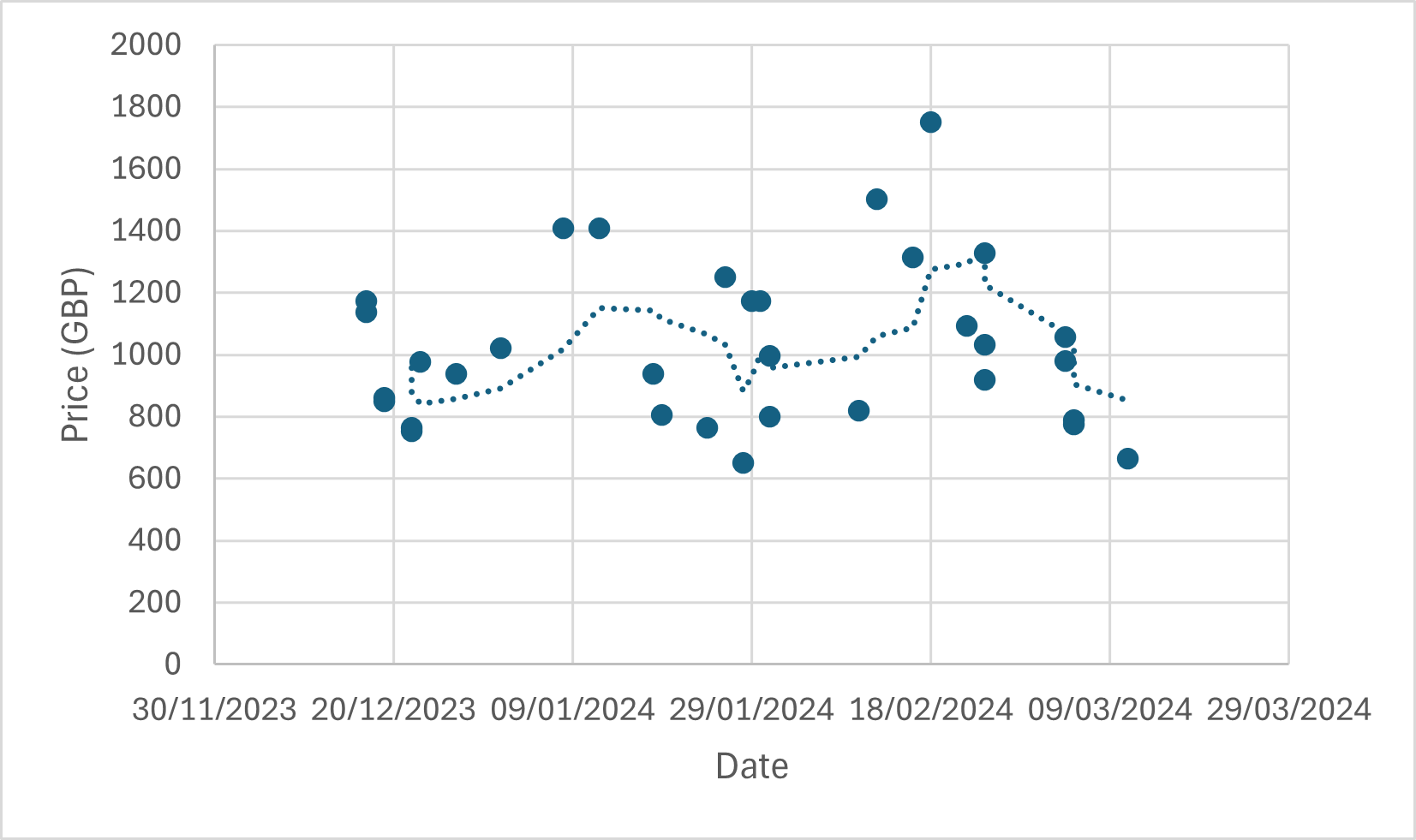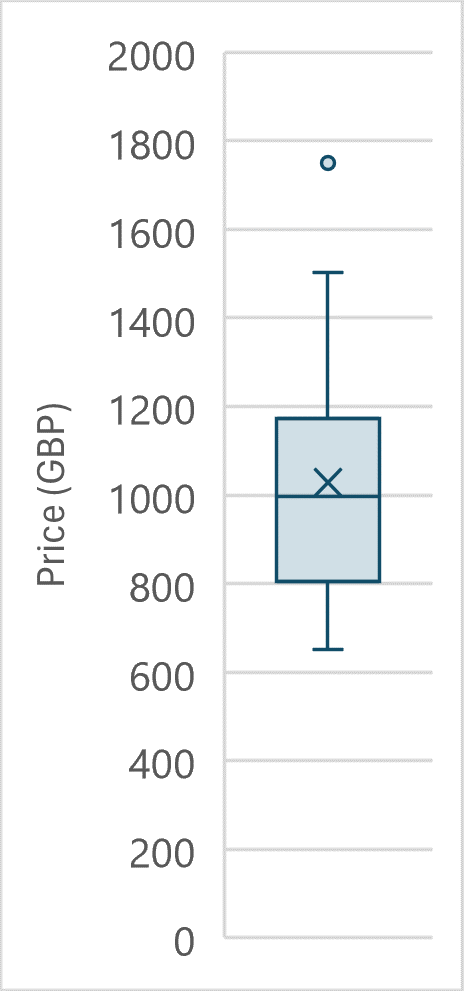The Curta was one of the last mechanical calculators to be produced. It was the only truely portable calculator capable of all four basic arithmetic operations which is relatively easy to aquire, and now has an almost cult following. It is certainly the best known brand of calculator, and has the highest price of any with such a large production. They usually sell for £420 to £750 plus taxes on the Saleroom, and £700 to £1100 on Ebay. Functionality has a smaller effect than on most calculators, usually decreasing the price by 35% to 50%, although I have found that sellers are more likely to do their research, and any machine listed as untested will not work (this is of course different with auction houses, which generally put a lot less effort into online listings). This is probably because they are much harder to repair, requiring specialist tools, and they are easier to damage. I have compiled a graph of sale prices on Ebay, which can be found at the bottom of this page. My data begins in Autumn 2023.
The type I is smaller than the type II. It has the register format 8*6*11. There are three main variations, the distinction between which is clearly shown below. In both main models, there are almost endless variations, partly due to different spared being incorperated when machines were sent for repair. However, there are three main design differences in the type I. The biggest differences are in the text on the baseplate and the crank. A full table of all possible factory variations of the type 1 is available here (other variations are lso possible, as some machines were sent back o the factory for repairs, and so may have seemingly impossible combinations of parts). Although there were more produced (79527 as opposed to 61660), the type 1 is slightly more desirable to some collectors, and therefore they usually have a slightly higher price. Any rarer variations will be significantly more desirable, although there is a smaller market for these variations.
| Year | First Serial Number | Final Serial Number | Total Produced |
|---|---|---|---|
| 1947 | 901 | 3000 | 2100 |
| 1948 | 3001 | 6000 | 3000 |
| 1949 | 6001 | 9200 | 3200 |
| 1950 | 9201 | 12600 | 3400 |
| 1951 | 12601 | 16600 | 4000 |
| 1952 | 16601 | 20600 | 4000 |
| 1953 | 20601 | 24400 | 3800 |
| 1954 | 24401 | 18200 | 3800 |
| 1955 | 28201 | 32000 | 3800 |
| 1956 | 32001 | 35800 | 3800 |
| 1957 | 35801 | 38860 | 3060 |
| 1958 | 38861 | 40770 | 1910 |
| 1959 | 40771 | 41770 | 1000 |
| 1960 | 41771 | 45010 | 3240 |
| 1961 | 45011 | 49170 | 4160 |
| 1962 | 49171 | 52880 | 3710 |
| 1963 | 52881 | 56130 | 3250 |
| 1964 | 56131 | 58580 | 2450 |
| 1965 | 58581 | 62180 | 3600 |
| 1966 | 62181 | 65780 | 3600 |
| 1967 | 65781 | 68780 | 3000 |
| 1968 | 68781 | 73580 | 4800 |
| 1969 | 73581 | 77780 | 4200 |
| 1970 | 77781 | 80427 | 2647 |
| 79527 |
Very few of the type Ia were produced (approximately 50, of which less than 10 are known to survive). These are immensely valuable - see the page for unique and very rare calculators here.
The type II had the register format 11*8*15, and is therefore slightly larger. They were mostly grey, however some of the earlier ones still had the black body. These are only marginally less valuable than the type I. SNs 500000-510500 were black, and the rest were grey. There were many other variations, however this was the most drastic. Those with a black body are somewhat more valuable than the grey body, as this is a distinctive change and substantially fewer were made. A full table of the variants is available here. As with the type I, those with lower production are more valuable to collectors.
| Year | First Serial Number | Final Serial Number | Total Produced |
|---|---|---|---|
| 1954 | 500001 | 505120 | 5120 |
| 1955 | 505121 | 507120 | 2000 |
| 1956 | 507121 | 510020 | 2900 |
| 1957 | 510021 | 510520 | 500 |
| 1958 | 510521 | 511520 | 1000 |
| 1959 | 511521 | 513520 | 2000 |
| 1960 | 513521 | 516520 | 3000 |
| 1961 | 616521 | 519020 | 2500 |
| 1962 | 519021 | 522520 | 3500 |
| 1963 | 522521 | 526120 | 3600 |
| 1964 | 526121 | 530320 | 4200 |
| 1965 | 530321 | 533920 | 3600 |
| 1966 | 533921 | 539320 | 5400 |
| 1967 | 539321 | 544720 | 5400 |
| 1968 | 544721 | 549520 | 4800 |
| 1969 | 549521 | 554920 | 5400 |
| 1970 | 554921 | 560920 | 6000 |
| 1971 | 560921 | 561660 | 740 |
| 61660 |


For dating based on a serial number, see here (https://www.vcalc.net/cu-date.htm).
For variations see here (https://curta.li/01_type1/05_curta1_var00.html, type 1) or here (https://curta.li/02_type2/05_curta2_var00.html, type 2).
For a very technical look at the Curta, along with less well known similar calculators, see here (http://www.johnwolff.id.au/calculators/Mini/Mini.htm).
For those who understand German, a very detailed technical description along with some excellent photograhs of the mechanism can be found here (https://www.curta.de/kr41/curta_zerlegung.pdf).
http://www.curtamania.com/curta/code/original_records.html
https://en.wikipedia.org/wiki/Curta
https://www.jaapsch.net/mechcalc/curta.htm